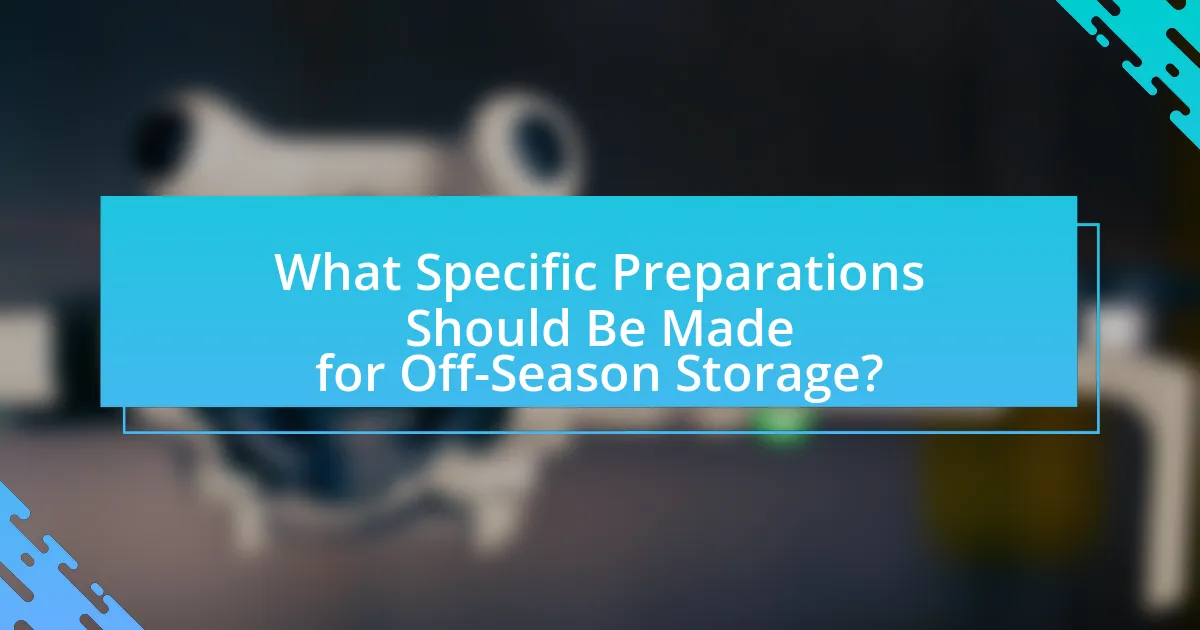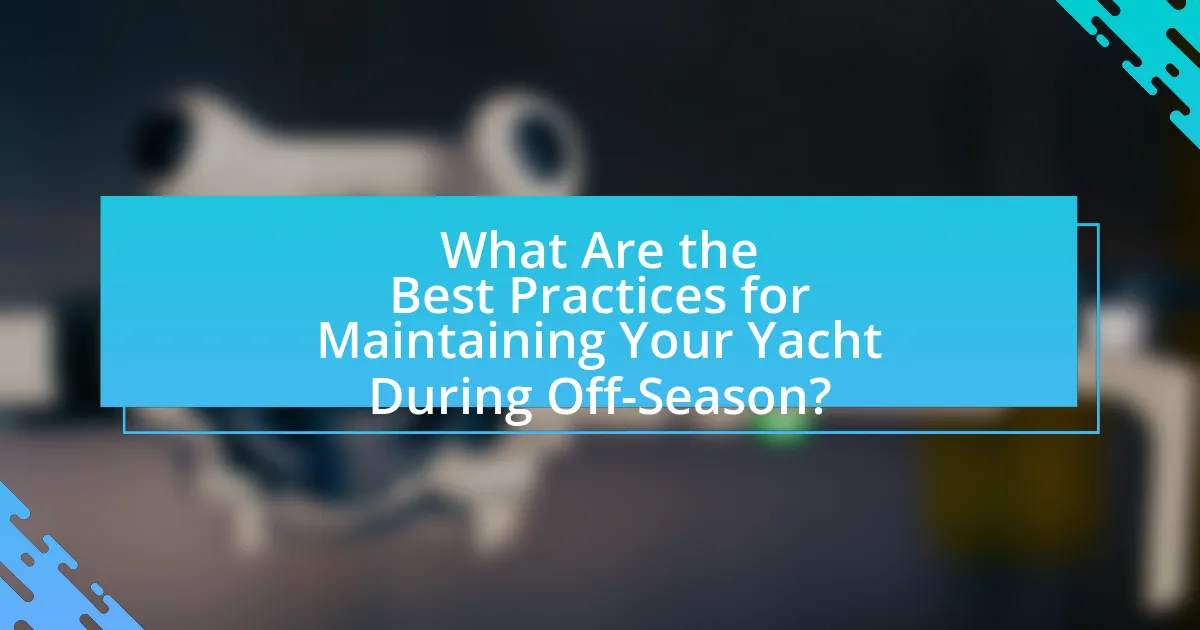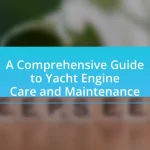The article focuses on the essential steps for properly storing a yacht during the off-season to maintain its condition and longevity. Key topics include thorough cleaning and inspection of the yacht, necessary maintenance tasks, and the importance of selecting an appropriate storage location. It also discusses various storage methods, including indoor and outdoor options, and emphasizes the significance of winterizing systems to prevent damage. Additionally, the article outlines best practices for securing the yacht against theft and environmental factors, as well as practical tips for successful off-season storage.

How Should You Prepare Your Yacht for Off-Season Storage?
To prepare your yacht for off-season storage, you should thoroughly clean, inspect, and protect it. Start by washing the exterior and interior to remove dirt, salt, and grime, which can cause damage over time. Next, inspect the hull, engine, and all systems for any signs of wear or damage, addressing any issues before storage. Additionally, protect the yacht by applying a coat of wax to the hull and using a high-quality cover to shield it from environmental elements. Properly winterizing the engine and systems, including draining water and adding antifreeze, is crucial to prevent freezing and damage. These steps are essential as they help maintain the yacht’s condition and longevity during the off-season.
What are the initial steps to take before storing your yacht?
The initial steps to take before storing your yacht include cleaning the vessel thoroughly, removing all personal items, and conducting necessary maintenance checks. Cleaning the yacht prevents mold and mildew growth during storage, while removing personal items ensures nothing is damaged or lost. Maintenance checks, such as inspecting the engine, batteries, and hull, help identify any repairs needed before storage, which can prolong the yacht’s lifespan and performance.
How do you clean and inspect your yacht before storage?
To clean and inspect your yacht before storage, start by thoroughly washing the exterior with a marine-safe soap to remove dirt, salt, and grime. After cleaning, inspect the hull for any signs of damage, such as cracks or blisters, which can compromise the vessel’s integrity. Next, check the engine and fuel systems for leaks or corrosion, ensuring all fluids are topped off or replaced as necessary. Additionally, inspect the electrical systems, including batteries, to confirm they are functioning properly and securely stored. Finally, clean and dry the interior, removing any food items and moisture to prevent mold and mildew during storage. Regular maintenance and inspection can extend the life of the yacht and ensure it is ready for use when the season resumes.
What maintenance tasks should be completed prior to storage?
Prior to storage, essential maintenance tasks for a yacht include cleaning the exterior and interior, checking and repairing any damage, changing the oil and filters, and ensuring the fuel system is treated with a stabilizer. Cleaning prevents mold and mildew, while checking for damage ensures safety and longevity. Changing oil and filters removes contaminants, and treating the fuel system prevents degradation during storage. These tasks are critical for maintaining the yacht’s condition and performance when it is taken out of storage.
Why is it important to choose the right storage location?
Choosing the right storage location for a yacht is crucial to ensure its protection and longevity. A suitable storage location minimizes exposure to environmental elements such as moisture, UV rays, and temperature fluctuations, which can lead to damage like mold growth, fading, and structural deterioration. For instance, storing a yacht indoors or in a climate-controlled facility can significantly reduce these risks compared to outdoor storage. Additionally, a well-chosen location can enhance security against theft and vandalism, further safeguarding the investment.
What factors should you consider when selecting a storage facility?
When selecting a storage facility for your yacht during the off-season, consider location, security, climate control, accessibility, and cost. The location should be convenient for transportation to and from the water, while security measures like surveillance and gated access protect your investment. Climate control is essential to prevent damage from humidity or temperature fluctuations, especially for sensitive materials. Accessibility ensures you can easily access your yacht for maintenance or inspections. Lastly, compare costs among facilities to find a balance between affordability and the services offered, as prices can vary significantly based on these factors.
How does the climate affect your storage options?
Climate significantly influences storage options for yachts during the off-season. In regions with harsh winters, yachts require indoor storage to protect them from freezing temperatures, snow, and ice, which can cause structural damage and affect mechanical systems. Conversely, in warmer climates, outdoor storage may be viable, but it necessitates protective covers to shield against UV damage and moisture, which can lead to mold and corrosion. For instance, the National Oceanic and Atmospheric Administration reports that prolonged exposure to high humidity can deteriorate materials used in yacht construction. Therefore, understanding local climate conditions is essential for selecting appropriate storage methods that ensure the longevity and maintenance of the yacht.
What are the different storage methods available for yachts?
The different storage methods available for yachts include dry storage, wet storage, and indoor storage. Dry storage involves placing the yacht on land, typically on a trailer or in a storage facility, which protects it from water damage and allows for maintenance work. Wet storage, on the other hand, keeps the yacht in the water at a marina or dock, making it easily accessible for use but exposing it to potential weather-related wear. Indoor storage provides a controlled environment, shielding the yacht from environmental elements, pests, and UV damage, often found in specialized storage facilities. Each method has its advantages and is chosen based on factors such as budget, location, and the yacht’s size.
How does indoor storage compare to outdoor storage?
Indoor storage offers better protection for yachts compared to outdoor storage. Indoor facilities shield yachts from environmental factors such as UV rays, rain, and snow, which can cause damage over time. Additionally, indoor storage typically provides enhanced security features, reducing the risk of theft or vandalism. According to a study by the National Marine Manufacturers Association, boats stored indoors maintain their value better due to reduced wear and tear from weather exposure. In contrast, outdoor storage may be more cost-effective but exposes yachts to the elements, potentially leading to higher maintenance costs in the long run.
What are the pros and cons of shrink-wrapping your yacht?
Shrink-wrapping a yacht offers several advantages and disadvantages. The primary benefit is protection from environmental elements, such as UV rays, moisture, and debris, which can lead to damage during the off-season. This method also provides a secure barrier against pests and rodents, reducing the risk of infestations. Additionally, shrink-wrapping is relatively cost-effective compared to other storage options, with prices typically ranging from $15 to $25 per linear foot, depending on the size of the yacht.
On the downside, shrink-wrapping can trap moisture inside if not done correctly, potentially leading to mold and mildew growth. Furthermore, the process requires specialized equipment and expertise, which may incur additional costs if hiring professionals. Lastly, removing the shrink wrap can be labor-intensive and may require disposal fees, as the material is not recyclable.

What Specific Preparations Should Be Made for Off-Season Storage?
To prepare a yacht for off-season storage, owners should thoroughly clean the vessel, remove all perishable items, and ensure that the fuel system is treated with a stabilizer to prevent degradation. Cleaning involves washing the exterior and interior to eliminate salt, dirt, and mildew, which can cause damage over time. Removing perishable items, such as food and personal belongings, prevents mold and pests. Treating the fuel system with a stabilizer is crucial, as it helps maintain fuel quality during storage, reducing the risk of engine issues when the yacht is next used.
How do you properly winterize your yacht?
To properly winterize your yacht, begin by thoroughly cleaning the interior and exterior to prevent mold and mildew. Next, drain all water systems, including the fresh water and waste systems, to avoid freezing and damage. After draining, add antifreeze to the plumbing lines to protect against low temperatures. Additionally, remove and store any valuable equipment and electronics in a dry, safe location.
Next, ensure the fuel tank is full and add a fuel stabilizer to prevent degradation during storage. Change the engine oil and replace the oil filter to protect the engine from corrosion. Finally, cover the yacht with a breathable cover to shield it from snow and ice while allowing moisture to escape. Following these steps helps maintain the yacht’s condition and prolongs its lifespan during the off-season.
What systems need to be winterized to prevent damage?
The systems that need to be winterized to prevent damage include the engine cooling system, fuel system, water systems, and electrical systems. The engine cooling system requires antifreeze to prevent freezing and cracking, while the fuel system should be treated with fuel stabilizer to prevent degradation. Water systems, including fresh water and waste systems, must be drained and winterized with antifreeze to avoid freezing and bursting pipes. Lastly, electrical systems should be checked and batteries removed or maintained to prevent damage from cold temperatures. Proper winterization of these systems is essential to ensure the yacht remains in good condition during the off-season.
How do you protect the engine and fuel systems during storage?
To protect the engine and fuel systems during storage, it is essential to add a fuel stabilizer to the fuel tank and run the engine for a few minutes to ensure the stabilizer circulates throughout the system. This process prevents fuel degradation and the formation of varnish, which can clog fuel lines and injectors. Additionally, draining the fuel system and replacing it with fresh fuel before storage can further mitigate risks associated with stale fuel. Regular maintenance, such as changing the oil and filters, also contributes to engine protection during the off-season. These practices are supported by marine maintenance guidelines, which emphasize the importance of fuel quality and engine care in preventing long-term damage.
What steps should be taken to secure your yacht during off-season?
To secure your yacht during the off-season, first, ensure that it is thoroughly cleaned and inspected for any damage. This includes washing the hull, cleaning the interior, and checking for leaks or wear. Next, remove all valuable items and personal belongings to prevent theft. Additionally, cover the yacht with a high-quality tarp or shrink wrap to protect it from the elements, including UV rays and moisture.
Furthermore, disconnect the battery and ensure that all systems are properly winterized, including the engine and plumbing, to prevent freezing and damage. Finally, store the yacht in a secure location, such as a marina or a storage facility with surveillance, to enhance security against theft and vandalism. These steps are essential for maintaining the yacht’s condition and ensuring its safety during the off-season.
How can you ensure your yacht is safe from theft or vandalism?
To ensure your yacht is safe from theft or vandalism, implement a combination of security measures including installing a robust alarm system, using high-quality locks, and employing surveillance cameras. These measures deter potential thieves and provide evidence in case of an incident. According to the National Marine Manufacturers Association, yachts equipped with security systems are significantly less likely to be targeted, as they increase the perceived risk for criminals. Additionally, storing the yacht in a secure marina or facility with controlled access further enhances safety, as these locations often have additional security protocols in place.
What measures can be taken to prevent water damage?
To prevent water damage, ensure proper sealing of all openings and use waterproof covers for the yacht. Regularly inspect and maintain the hull, ensuring that any cracks or leaks are promptly repaired to avoid water intrusion. Additionally, store the yacht in a dry, well-ventilated area to minimize moisture buildup. Implementing these measures significantly reduces the risk of water damage, as studies show that proactive maintenance can decrease repair costs by up to 50%.

What Are the Best Practices for Maintaining Your Yacht During Off-Season?
The best practices for maintaining your yacht during the off-season include thorough cleaning, proper storage, and regular inspections. Cleaning involves removing all dirt, salt, and debris from the yacht’s surfaces to prevent corrosion and mold growth. Proper storage requires placing the yacht in a climate-controlled environment or using a quality cover to protect it from harsh weather conditions. Regular inspections should focus on checking the hull, engine, and electrical systems to identify any potential issues before the next season. These practices help ensure the yacht remains in optimal condition, extending its lifespan and maintaining its value.
How can you regularly check on your yacht during storage?
To regularly check on your yacht during storage, schedule periodic inspections to assess its condition. These inspections should include checking for signs of moisture, mold, or pests, as well as ensuring that the cover is intact and that no debris has accumulated. Regular checks help prevent damage and maintain the yacht’s integrity, as studies show that moisture can lead to significant structural issues if not addressed promptly. Additionally, documenting each inspection can provide a clear record of the yacht’s condition over time, which is beneficial for maintenance and resale value.
What should you look for during periodic inspections?
During periodic inspections of a yacht, you should look for signs of wear and tear, moisture accumulation, and structural integrity. Inspecting the hull for cracks or blisters, checking the condition of the rigging and sails, and ensuring that all mechanical systems, such as the engine and electrical components, are functioning properly are essential. Additionally, verifying that the bilge is clean and free of debris, and that the storage area is dry and well-ventilated helps prevent mold and corrosion. Regular inspections can identify potential issues early, reducing repair costs and ensuring the yacht remains in optimal condition during the off-season.
How often should you visit your yacht during the off-season?
You should visit your yacht at least once a month during the off-season. Regular monthly visits allow you to check for any maintenance issues, ensure that the yacht is properly secured, and prevent potential damage from environmental factors. According to the American Boat and Yacht Council, regular inspections can help identify problems early, which can save significant repair costs and ensure the longevity of the vessel.
What common mistakes should be avoided when storing a yacht?
Common mistakes to avoid when storing a yacht include neglecting to clean the vessel thoroughly, failing to properly winterize the engine and systems, and overlooking the importance of using a quality cover. Cleaning the yacht prevents mold and mildew, which can damage surfaces and systems. Proper winterization, including draining water systems and adding antifreeze, protects against freezing and corrosion, which can lead to costly repairs. Using a high-quality cover shields the yacht from UV damage and environmental elements, preserving its condition. These practices are essential for maintaining the yacht’s integrity and longevity during off-season storage.
How can improper storage affect your yacht’s longevity?
Improper storage can significantly reduce a yacht’s longevity by exposing it to environmental damage, structural deterioration, and mechanical issues. When a yacht is not stored correctly, factors such as moisture, UV rays, and temperature fluctuations can lead to mold growth, corrosion of metal components, and degradation of the hull and interior materials. For instance, a study by the National Marine Manufacturers Association indicates that boats stored in damp conditions are 50% more likely to suffer from mold and mildew, which can compromise both safety and aesthetics. Additionally, neglecting to winterize engines and systems can result in costly repairs, as frozen fluids can crack engine blocks. Therefore, proper storage is essential to maintain a yacht’s condition and extend its operational life.
What are the consequences of neglecting maintenance during storage?
Neglecting maintenance during storage can lead to significant damage to the yacht, including corrosion, mold growth, and mechanical failures. Corrosion occurs when metal components are exposed to moisture without protective coatings, leading to structural weaknesses. Mold growth can thrive in damp environments, damaging upholstery and wood surfaces. Additionally, mechanical failures may arise from stagnant fluids, which can cause engine and system malfunctions. According to a study by the American Boat and Yacht Council, proper maintenance can extend the lifespan of a yacht by up to 30%, highlighting the importance of regular upkeep during storage.
What are some practical tips for successful off-season yacht storage?
To ensure successful off-season yacht storage, it is essential to clean and inspect the yacht thoroughly before storage. This includes washing the exterior, cleaning the interior, and checking for any maintenance issues such as leaks or corrosion. Properly draining all fluids, including fuel and water, prevents damage from freezing temperatures. Additionally, covering the yacht with a high-quality cover protects it from environmental elements. Storing the yacht in a climate-controlled facility can further safeguard it against extreme weather conditions. Regularly checking on the yacht during the off-season helps identify any potential issues early. These practices are supported by industry standards, which emphasize the importance of maintenance and protection to extend the lifespan of the yacht.
How can you create a checklist for off-season storage tasks?
To create a checklist for off-season storage tasks, start by identifying essential tasks such as cleaning, maintenance, and securing the yacht. Break down each task into specific actions, for example, washing the hull, checking the engine, and removing valuables. Organize these tasks by priority and timeline, ensuring that critical maintenance is completed first. Include a section for materials needed, such as cleaning supplies and tools, to streamline the process. This structured approach ensures that all necessary steps are covered, reducing the risk of damage during storage.
What resources are available for yacht owners during the off-season?
Yacht owners have access to several resources during the off-season, including storage facilities, maintenance services, and insurance options. Storage facilities provide secure environments for yachts, often offering climate control and protection from environmental elements. Maintenance services, such as cleaning, repairs, and inspections, ensure that the yacht remains in optimal condition during the off-season. Additionally, yacht owners can explore insurance options tailored for off-season coverage, protecting their investment from potential damages or liabilities while the yacht is not in use. These resources collectively help yacht owners manage their vessels effectively during the off-season.















